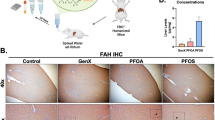Abstract
Catalase and superoxide dismutase activities in the liver of NZW mice are 29.3 μmol H2O2/min×mg protein and 10.6 U/mg protein, respectively. The rate of accumulation of lipid peroxidation (LPO) products is low within the first 60 min of incubation of liver homogenates with ascorbate and then rapidly increases. A similar process is observed with Fe+ascorbate system, where LPO rate is markedly higher and lag-period lasts 10 min. Under the action of cyclophosphane the activity of catalase increases by 32%, while that of superoxide dismutase decreases by 46%, which is accompanied by a decline in the sensitivity of liver tissue to LPO induction. When LPO is inducedin vitro by ascorbate, lag-period decreases 2-fold, while the rate of accumulation of LPO products increases by 38% and their maximum level by 35% compared with the control. Similar processes develop in the Fe+ascorbate system. Dioxydine induces no significant changes in the activities of catalase and superoxide dismutase as well as in LPO product accumulation in the ascorbate and Fe+ascorbate systems.
Similar content being viewed by others
References
A. D. Durnev, T. G. Sazontova, N. V. Guseva, and S. B. Seredenin,Byull. Eksp. Biol. Med.,121, No. 5, 528–532 (1996).
G. N. Pleskovskaya,Revmatologiya, No. 4, 38–44 (1991).
S. B. Seredenin and A. D. Durnev,Pharmacological Protection of Genome [in Russian], Moscow (1992).
M. U. Dianzani,Crit. Rev. Oncol. Hematol.,15, No. 2, 125–147 (1993).
G. G. Duthic,Eur. J. Clin. Nutr.,47, No. 11, 759–764 (1993).
I. Fridovich,Account Chem. Res.,5, 321–326 (1972).
H. Joenje,Mutat. Res.,214, No. 4, 193–208 (1989).
F. Leighton, B. Poole, H. Beaufay,et al., J. Cell Biol.,37, 482–513 (1968).
H. Luck, in:Methods of Enzymatic Analysis, New York (1963), pp. 885–894.
H. Okhawa, N. Ohishi, and K. Yagi,Anal. Biochem.,95, No. 2, 351–358 (1979).
C. E. Vaca and M. Harms-Ringdahl,Biochim. Biophys. Acta.,1001, No. 1, 35–43 (1989).
Author information
Authors and Affiliations
Additional information
Translated fromByulleten’ Eksperimental’noi Biologii i Meditsiny, Vol. 123, No. 4, pp. 381–384, April, 1997
Rights and permissions
About this article
Cite this article
Sazontova, T.G., Guseva, N.V., Lisitsina, T.A. et al. Activity of antioxidant enzymes and lipid peroxidation in intact and mutagen-treated NZW mice. Bull Exp Biol Med 123, 328–330 (1997). https://doi.org/10.1007/BF02766178
Received:
Issue Date:
DOI: https://doi.org/10.1007/BF02766178




